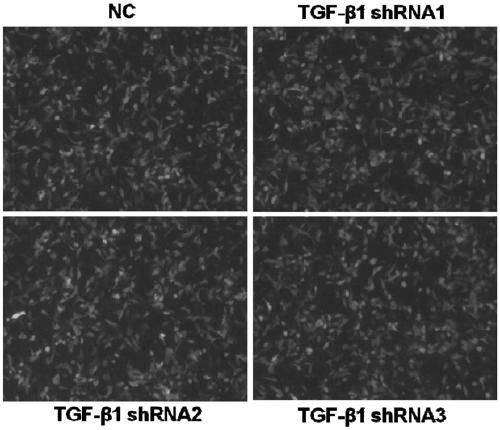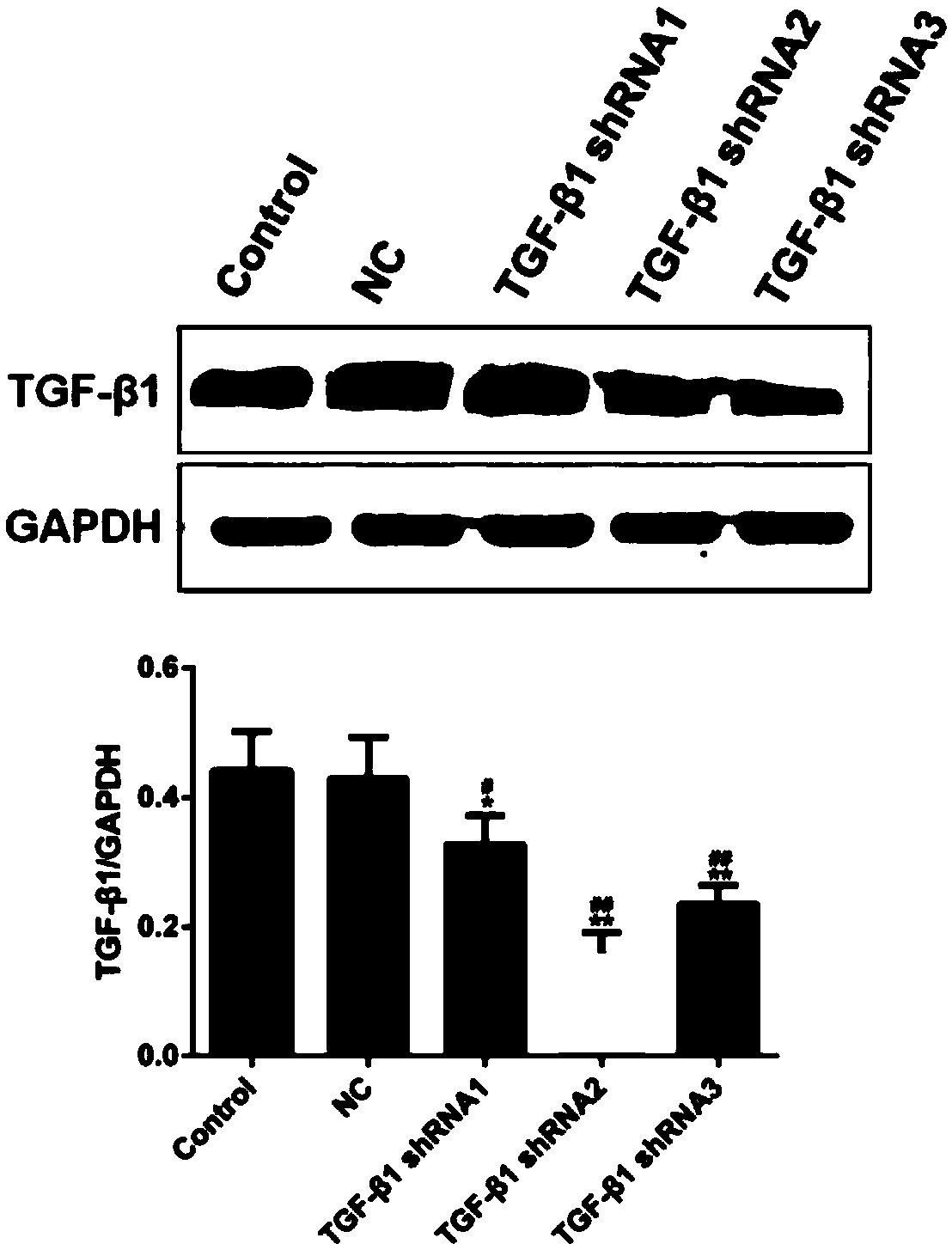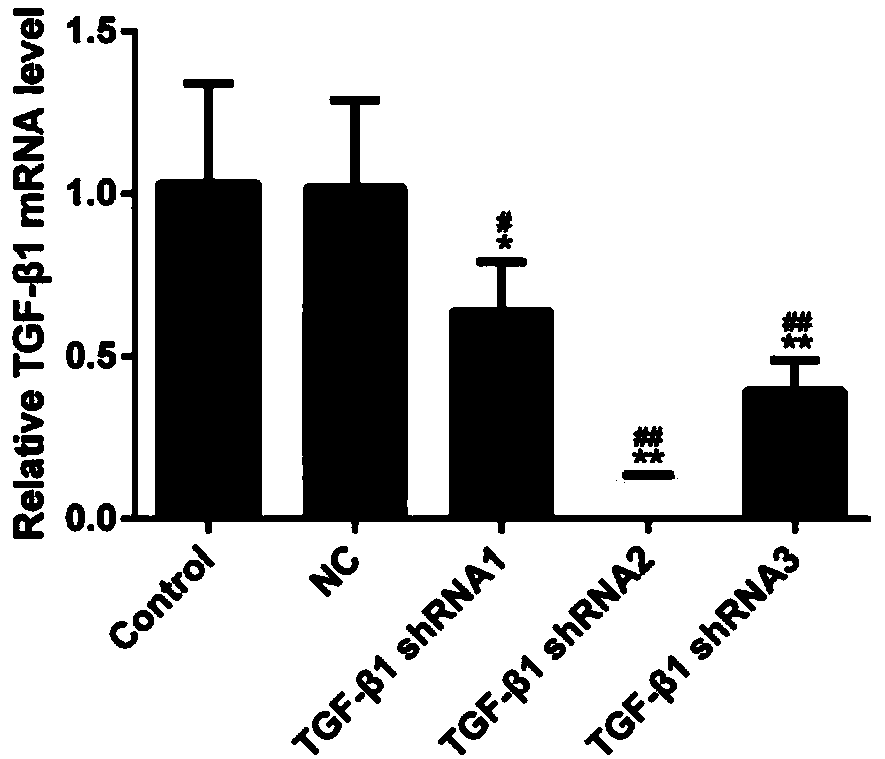shRNA and vector for knocking down TGF-beta1 (Transforming Growth Factor-beta 1), kit and application of shRNA or vector or kit
A TGF-, kit technology, applied in the field of TGF-β1 knockdown shRNA, carrier, can solve the problem of large organ differences, undisclosed specific mechanism of action, unfavorable diagnosis of neurogenic bladder fibrosis, and development of targeted drugs for treatment, etc. problems, to achieve the effect of inhibiting fibrosis
- Summary
- Abstract
- Description
- Claims
- Application Information
AI Technical Summary
Problems solved by technology
Method used
Image
Examples
Embodiment 1
[0033]The siRNA target was designed, and the primer shRNA was synthesized. The siRNA sequence and the shRNA sequence are shown in Tables 1-2. The primers were annealed to form double-stranded fragments with cohesive ends, the expression vector was digested with restriction endonucleases BamHI and EcoRI, and the digested products were recovered. Interfering fragments were ligated into expression vectors, ligated products were ligated overnight at 16°C, transformed into competent cells DH5α, positive bacteria were picked, and confirmed by sequencing. A large number of lentiviral vector pHBLVTM and auxiliary plasmids pSPAX2 and pMD2G determined by sequencing were extracted, and the virus was packaged and the titer of the virus was determined.
[0034] Table 1 siRNA sequence
[0035] name
sequence
mock siRNA
TTCTCCGAACGTGTCACGTAA (SEQ ID NO: 1)
TGF-β1-siRNA1
ACAATTCCTGGCGTTACCTTGGTAA (SEQ ID NO: 2)
TGF-β1-siRNA2
GCAAAGATAATGTACTCCACGT...
Embodiment 2
[0040] Rats were killed by neck dissection, fresh bladder tissue specimens were cut under sterile conditions, primary rat bladder detrusor cells were isolated and purified, inoculated in 6-well plates, and added or not in the manner described in Table 3 Add the lentivirus and carry out the grouping test. After 48 hours of infection, observe under the fluorescent inverted microscope, the cells infected with the lentiviral vector carrying the GFP gene emit green fluorescence. After 72 hours of infection, observe the expression of green fluorescent protein in the GFP group, judge the transfection efficiency of the virus and take pictures (for specific transfection effects, see figure 1 ), the expression level of TGF-β1 protein in each group of cells was further detected by WB (for specific results, see figure 2 ), the mRNA transcription level of TGF-β1 in the cells of each group was detected by qRT-PCR (for specific results, see image 3 ).
[0041] according to figure 2 The...
Embodiment 3
[0045] Construct neurogenic bladder fibrosis model: After successful isoflurane anesthesia, the rats were fixed on the operating table in the prone position, and the sternum was found by hand as a bony landmark approximately at the level of the forelimbs, and the surgical site was determined. For the burrow towel, cut the back skin longitudinally about 2cm long, bluntly separate the subcutaneous and muscle tissue, and spread it with a spreader to fully expose the T9 spinal cord. Use scissors to cut the spinal cord transversely. The tail moved violently, and then the two stumps were lifted with tweezers, and the spinal canals at the two stumps were visible, which proved that the nerves at this part had been completely severed, and gelatin sponge was filled between the two stumps. After complete hemostasis, the layers are closed sequentially. The animals were put into the recovery room for observation, and then returned to the animal room after waking up. Method of the control ...
PUM
 Login to View More
Login to View More Abstract
Description
Claims
Application Information
 Login to View More
Login to View More - R&D
- Intellectual Property
- Life Sciences
- Materials
- Tech Scout
- Unparalleled Data Quality
- Higher Quality Content
- 60% Fewer Hallucinations
Browse by: Latest US Patents, China's latest patents, Technical Efficacy Thesaurus, Application Domain, Technology Topic, Popular Technical Reports.
© 2025 PatSnap. All rights reserved.Legal|Privacy policy|Modern Slavery Act Transparency Statement|Sitemap|About US| Contact US: help@patsnap.com



